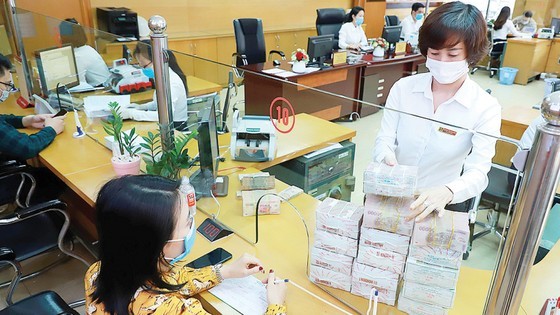 Illustrative image. (Photo: SGGP)
Illustrative image. (Photo: SGGP)
This is thanks to the 2-percent interest rate support package and banks’ measures to cut input costs, according to Dr. Hoang Van Cuong, vice president of the National Economics University.
The Government in May this year issued a decree on interest rate support from the State budget for loans of enterprises.
According to Cuong, though firms are looking forward to the 2-percent interest rate support package to get cheap capital for their production and business, in fact the number of firms that have been able to access the package and newly disbursed loans under the package have so far been restricted.
He attributed the restriction to the banks’ credit room. Most banks have so far used up all credit quota granted by the State Bank of Vietnam so that they cannot expand credit despite firms’ capital shortage.
As Vietnam’s inflation in the first half of this year was well controlled at 2.24 percent and the amount of money supplied to the economy over the past years was not much, the official said it is necessary to expand the credit quota for banks so that they can boost lending and firms can access the interest support package.
The interest rate support package therefore can really aid firms and have a positive impact on the economy, he said.
According to Cuong, besides the package, banks have been also forced to take measures to save input costs and better manage loans to reduce risk provisions, so as to cut lending interest rates as directed by the SBV.
Currently, some banks are also applying preferential interest rates of about 6.7-8.1 percent per year for 60-180-month business loans.
Saigon Securities Incorporation (SSI) forecast the State Bank of Vietnam will expand the credit quota for some banks in the third quarter of this year and the move will cause the deposit interest rate to rise by 50-70 basis points.
As for the whole of 2022, the SSI expected the deposit interest rates to increase by 1-1.5 percentage points against 2021 while lending interest rates for new disbursements will be up 1-2 percent.
For 2023, SSI forecast interest rates will be different in the first half and the second half of the year. Accordingly, the rates will remain under upward pressure in the first half of 2023 as the consumer price index (CPI) is estimated at 5.2 percent. They then will likely cool down in the second half of 2023 when inflationary pressures gradually ease with CPI estimated at 3.4 percent.
For the whole of 2023, the rates are expected to increase by about 70-80 basis points, reaching the rates before the pandemic.
The Government in May this year issued a decree on interest rate support from the State budget for loans of enterprises.
According to Cuong, though firms are looking forward to the 2-percent interest rate support package to get cheap capital for their production and business, in fact the number of firms that have been able to access the package and newly disbursed loans under the package have so far been restricted.
He attributed the restriction to the banks’ credit room. Most banks have so far used up all credit quota granted by the State Bank of Vietnam so that they cannot expand credit despite firms’ capital shortage.
As Vietnam’s inflation in the first half of this year was well controlled at 2.24 percent and the amount of money supplied to the economy over the past years was not much, the official said it is necessary to expand the credit quota for banks so that they can boost lending and firms can access the interest support package.
The interest rate support package therefore can really aid firms and have a positive impact on the economy, he said.
According to Cuong, besides the package, banks have been also forced to take measures to save input costs and better manage loans to reduce risk provisions, so as to cut lending interest rates as directed by the SBV.
Currently, some banks are also applying preferential interest rates of about 6.7-8.1 percent per year for 60-180-month business loans.
Saigon Securities Incorporation (SSI) forecast the State Bank of Vietnam will expand the credit quota for some banks in the third quarter of this year and the move will cause the deposit interest rate to rise by 50-70 basis points.
As for the whole of 2022, the SSI expected the deposit interest rates to increase by 1-1.5 percentage points against 2021 while lending interest rates for new disbursements will be up 1-2 percent.
For 2023, SSI forecast interest rates will be different in the first half and the second half of the year. Accordingly, the rates will remain under upward pressure in the first half of 2023 as the consumer price index (CPI) is estimated at 5.2 percent. They then will likely cool down in the second half of 2023 when inflationary pressures gradually ease with CPI estimated at 3.4 percent.
For the whole of 2023, the rates are expected to increase by about 70-80 basis points, reaching the rates before the pandemic.












)

)









